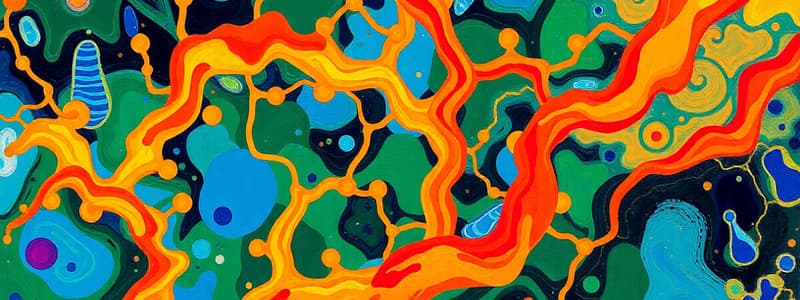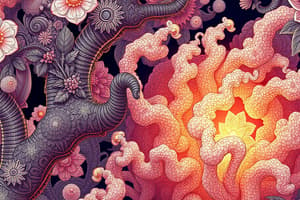Podcast
Questions and Answers
What characterizes the carbohydrate chains of glycoproteins?
What characterizes the carbohydrate chains of glycoproteins?
- They are exclusively found in membrane-bound glycoproteins.
- They are typically long and linear.
- They usually consist of repeating disaccharide units.
- They are usually two to ten sugar residues long and may be branched. (correct)
Which statement accurately describes the synthesis of N-linked glycoproteins?
Which statement accurately describes the synthesis of N-linked glycoproteins?
- They are synthesized exclusively in the plasma.
- They are produced solely from nucleotide sugars.
- They involve the transfer of a preformed oligosaccharide to asparagine residues. (correct)
- They are synthesized in the rough endoplasmic reticulum without any precursors.
What causes mucopolysaccharidoses?
What causes mucopolysaccharidoses?
- Defects in the targeting of glycoproteins to the Golgi apparatus.
- Deficiencies in the degradation of glycosaminoglycans. (correct)
- Increased synthesis of core proteins in proteoglycans.
- Elevated levels of lysosomal enzymes in the blood.
The presence of sulfated compounds in urine may indicate a deficiency in which enzyme?
The presence of sulfated compounds in urine may indicate a deficiency in which enzyme?
What is the primary biochemical defect causing I-cell disease?
What is the primary biochemical defect causing I-cell disease?
Hurler syndrome is confirmed by the deficiency of which enzyme?
Hurler syndrome is confirmed by the deficiency of which enzyme?
In I-cell disease, what is a notable change in the blood levels of certain substances?
In I-cell disease, what is a notable change in the blood levels of certain substances?
What distinguishes glycoproteins from proteoglycans?
What distinguishes glycoproteins from proteoglycans?
Which condition results from the accumulation of partially degraded structures in lysosomes?
Which condition results from the accumulation of partially degraded structures in lysosomes?
What type of sugars primarily compose the repeating unit in glycosaminoglycans (GAGs)?
What type of sugars primarily compose the repeating unit in glycosaminoglycans (GAGs)?
What are large complexes of negatively charged heteropolysaccharides known as?
What are large complexes of negatively charged heteropolysaccharides known as?
Which of the following is NOT a type of glycosaminoglycan (GAG)?
Which of the following is NOT a type of glycosaminoglycan (GAG)?
What is the role of glycosaminoglycans (GAGs) in the body?
What is the role of glycosaminoglycans (GAGs) in the body?
What happens when there is a deficiency of lysosomal acid hydrolases in relation to GAGs?
What happens when there is a deficiency of lysosomal acid hydrolases in relation to GAGs?
Which molecule is involved in the last step of GAG synthesis by providing sulfate?
Which molecule is involved in the last step of GAG synthesis by providing sulfate?
How are GAGs primarily structured within the body?
How are GAGs primarily structured within the body?
What is the difference between hyaluronic acid and other GAGs?
What is the difference between hyaluronic acid and other GAGs?
Which of the following conditions is associated with the accumulation of GAGs in tissues?
Which of the following conditions is associated with the accumulation of GAGs in tissues?
What are the primary amino sugars found in GAGs?
What are the primary amino sugars found in GAGs?
Where are glycosaminoglycans (GAGs) synthesized in the cell?
Where are glycosaminoglycans (GAGs) synthesized in the cell?
Flashcards are hidden until you start studying
Study Notes
Glycosaminoglycans (GAGs)
- Composed of long, negatively charged, unbranched heteropolysaccharide chains with repeating disaccharide units: [acidic sugar–amino sugar]n.
- Amino sugars can be D-glucosamine or D-galactosamine, typically acetylated to eliminate a positive charge.
- Acidic sugars include D-glucuronic acid and its epimer L-iduronic acid.
- Crucial for retaining water, contributing to a gel-like matrix in the body's ground substance.
- GAGs are known for their viscous properties, leading to the historical term "mucopolysaccharides."
- Major types include chondroitin 4- and 6-sulfates, keratan sulfate, dermatan sulfate, heparin, heparan sulfate, and hyaluronic acid.
- All GAGs, except hyaluronic acid, are covalently linked to proteins, forming proteoglycan monomers with a core protein.
- Synthesized in the Golgi through the addition of alternating acidic and amino sugars donated by UDP derivatives.
- Characterized by possible sulfation of amino sugars derived from 3′-phosphoadenosyl-5′-phosphosulfate.
- Degraded by lysosomal acid hydrolases; a deficiency leads to mucopolysaccharidoses, causing skeletal deformities and intellectual disability.
- Common examples of mucopolysaccharidoses include Hunter and Hurler syndromes.
Glycoproteins
- Proteins that have short, branched oligosaccharide chains (2-10 sugar residues).
- Distinct from proteoglycans as they do not have long serial disaccharide units.
- Play roles in cell-surface recognition, antigenicity, and comprise extracellular matrix components.
- Major components of human plasma globular proteins are glycoproteins.
- Synthesized in the rough endoplasmic reticulum (RER) and Golgi from nucleotide sugars.
- O-linked glycoproteins formed by transferring sugars to serine or threonine residues; N-linked glycoproteins synthesized via transfer from dolichol pyrophosphate to asparagine residues.
- I-cell disease results from a deficiency in the phosphorylation of mannose residues in N-linked glycoprotein enzymes.
Lysosomal Storage Diseases
- Mucopolysaccharidosis caused by defects in GAG degradation rather than protein synthesis.
- Blood enzyme levels remain normal in storage diseases; the enzyme targeted to lysosomes is nonfunctional.
- I-cell disease showcases elevated blood acid hydrolases due to enzyme secretion failure, with subsequent lysosomal accumulation.
Diagnostic Questions and Answers
- Mucopolysaccharidoses are caused by deficiencies in lysosomal acid hydrolases responsible for GAG degradation.
- Urinary analysis showing sulfated compounds indicates deficiencies in sulfatase, essential for the degradation process.
- I-cell disease confirmed by elevated acid hydrolases in blood due to defective mannose 6-phosphate targeting.
- Hurler syndrome, indicated by corneal clouding and specific GAGs in urine, results from α-L-iduronidase deficiency.
Comparison: Glycoproteins vs. Proteoglycans
- Glycoproteins: Short, branched carbohydrate chains; diverse functions in cell recognition and signaling.
- Proteoglycans: Long GAG chains attached to core proteins; essential for structural components of extracellular matrices and create gel-like properties.
Studying That Suits You
Use AI to generate personalized quizzes and flashcards to suit your learning preferences.




